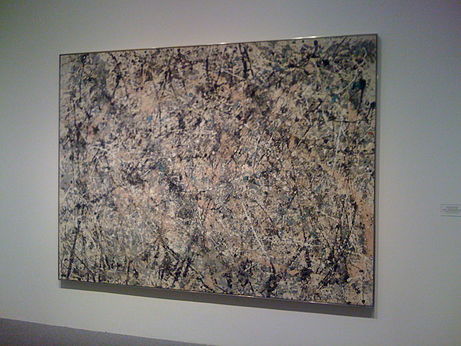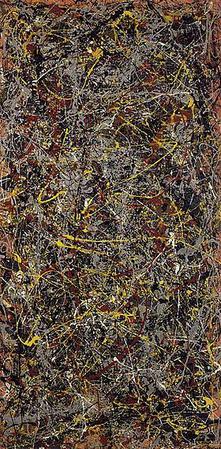Why I like Jackson Pollock
There are different kinds of art. Some art is more craft-like. I can admire the skill but it doesn't change the way I view the world around me. Some art is thought-provoking. It makes me reconsider some thought process that I had taken for granted. Some art is inspirational. It introduces me to a way of looking at things that had never before occurred to me. I find these kinds of art interesting and even motivating but they're not my favorite kind of art.
My favorite art is art that makes me believe that the creation of the work actually changed the artist's view of the world. I'm interested in artists who use art as a path towards knowledge. If an artist is essentially unchanged by the creation of their work then that is less interesting. I enjoy art that inspires me but I much prefer art that seems to have inspired the artist in a similar way. For me this is "real art". Art as a path towards truth.
I'm not knowledgeable about art or art history. I only know a little about Pollock himself. I've seen an exhibit that showed a progression of his art over the course of his life and included some biographic details. I'm a fan of Pollock the way I am a fan of a TV show or an author whose books I enjoy. But what I do know has led me to believe that Pollock used art as a path towards truth. Perhaps if I knew more about the man or his works my opinion would change. The purpose of this post, however, is not to convince you that you should like Pollock so much as it is to explain why I like Pollock. I'm not promising my opinion will never change, only explaining why it is what it is now.

Lavender Mist
Fair use, https://en.wikipedia.org/w/index.php?curid=20922211
First let's dismiss with the idea that Pollock's paintings were just random splashes of paint on a canvas. People who make this assertion, in my experience, have never actually created a painting by just randomly splashing (or dripping) paint on a canvas. Do the experiment. A random dripping or splashing of paint on a canvas just won't look like a Pollock. Mathematical analyses of Pollock's paintings show that they contain a fractal structure you don't find in random distributions of paint (or splashes or drips). Pollock always maintained that his paintings were intentional creations and we now have the statistical analyses to show that he was right.
Pollock, using his artistic intuition, was exploring the boundary between randomness and structure. In other words he was intuitively investigating chaos theory before the theory was developed. A Jackson Pollock painting is like an illustration of the difference between the fully structured and the completely random. He was basically pioneering the idea of quasi-randomness but in art rather than in math.
This all sounds rather dry and technical. But if you look at a progression of Pollack's work over the course of his life you will find that they convey a great deal of emotion. I will admit that if you only see one of his paintings then it's difficult to access this emotional content. Pollack's work, not unlike the work of a fine poet, is best understood once you've collected samples of his art from different periods in his life. If you do this, and if you learn just a little bit of what he was going through at that time in his life, it seems obvious that he was an artist who used art as a path to truth.
It's my belief (and again, perhaps I'm mistaken) that when you look at a collection of Pollock's paintings you aren't just seeing a reflection of how the artist changed during his life. You're seeing the impact his artistic creation had on his life. Pollack wasn't an artist who's work changed because he changed. Pollock was a person who changed because of his art.
Isn't that kind of art the most interesting?

No. 5, 1948
By Taken from Art Market Watch.com., Fair use, https://en.wikipedia.org/w/index.php?curid=7846487